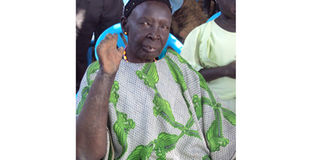West Nile registers high new leprosy infections

A woman living with leprosy displays her deformed limbs in Yumbe District on Monday. PHOTO | FELIX WAROM OKELLO
What you need to know:
- Statistics indicate that since 2000 Yumbe District has registered 326 cases of leprosy. Across the region, there were 44 cases registered in 2006, 30 cases in 2007 and 33 in 2008. In 2009, the region registered 11 cases, in 2010 (38) and 17 in 2011.
- According to Ministry of Health, whereas Uganda has achieved the target of elimination of leprosy as a social health problem, a number of new cases continue to be registered annually.
Health authorities in the West Nile Sub-region have revealed that they are registering new leprosy infections in communities of Yumbe, Nebbi, Adjumani, and Zombo districts.
Dr Filbert Nyeko, the Arua Regional Referral Hospital director, on Monday said leprosy is among the diseases that have been neglected.
He said despite the high cases of leprosy many doctors in the area have limited knowledge on treating the disease.
“We targeted 120 people suspected to be having leprosy but ended up with135 positive cases after screening. This means that we have more people suffering silently,” Dr Nyeko said.
He revealed that cases of leprosy are being reported in refugee settlements but they have no drugs to help combat the spread of the disease.
Ms Imelda Bitoi, a patient in Nebbi Town, told Daily Monitor on Monday that her skin started changing from black to red without her knowing that she had leprosy.
“I did not realise that I had contracted leprosy until those who knew about the disease started isolating me. However, some elders advised me to seek medical attention but we have no experts in our hospital,” she said.
She added: “If we had experts, leprosy cases would have been identified and treated.”
But the Rev Fr Pius Yobuta, the parish priest of Christ the King in Arua City, has advised the public to support leprosy patients.
“If you move from here to town, you find many people with leprosy begging. Do not neglect them, you can offer them anything that you have like clothes, food and even money. Let us support these people and be with them unlike in biblical times where they were banished from communities.”
Statistics indicate that since 2000 Yumbe District has registered 326 cases of leprosy.
Across the region, there were 44 cases registered in 2006, 30 cases in 2007 and 33 in 2008.
In 2009, the region registered 11 cases, in 2010 (38) and 17 in 2011.
According to Ministry of Health, whereas Uganda has achieved the target of elimination of leprosy as a social health problem, a number of new cases continue to be registered annually.
In 2009, the case detection rate was 1.2/100,000. New cases continue to occur but 2/3 of cases came from only 13 of the 112 districts.
The Nebbi Resident District Commissioner, Mr Robert Abak, accused health workers of failing to create awareness about the rising cases of leprosy and TB, which has prompted community members to seek treatment from witch doctors.
“Village Health Team (VHTs) are the foot soldiers in the communities and there’s need to empower them to identify cases of leprosy and tuberculosis (TB) since there are information gaps on such neglected diseases,” Abak said.
According to World Health Organisation statistics published in 2014, a total of 215 656 new leprosy cases were detected worldwide, although the number of leprosy cases is dropping.
About leprosy
Leprosy is caused by infection with the bacterium, mycobacterium leprae. It mainly affects the skin, eyes, nose and peripheral nerves. Its symptoms include light-coloured or red skin patches with reduced sensation, numbness and weakness in hands and feet.
While not highly infectious, it is transmitted via droplets, from the nose and mouth, during close and frequent contacts with untreated cases.




